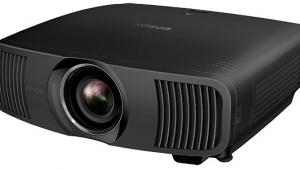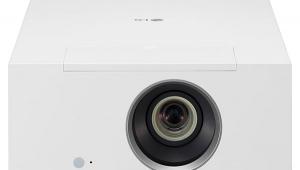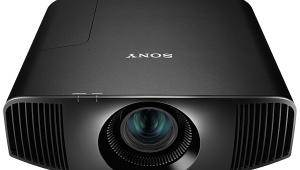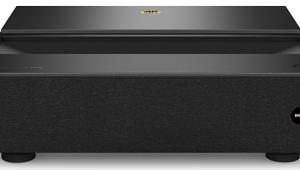Optoma H27 DLP Projector
Let's talk value. Super-sizing may no longer be en vogue in the fast-food realm, but it's alive and well in the world of home theater. If you're trying to put together a dedicated theater on a budget, remember this simple formula: More screen size for less money means greater value.

Of course, value is just one part of the overall equation. If the picture on that large screen isn't attractive to look at, what good is it? Thankfully, Optoma's budget-projector line has rendered that concern moot. The $1,500 H30 won our 2005 RAVE Award for Best Entry-Level Projector in our May 2005 issue, and the company has followed up that impressive performer with a model below the H30, the H27. It offers even better performance for an even smaller price tag: $1,199.
No, the H27 isn't an HD projector. Its 854-by-480 resolution qualifies it as an enhanced-definition display, ideally suited for DVD but also compatible with 1080i and 720p sources. It's more home theater friendly than the H30, with a true 16:9 chip and dedicated DVI and component video inputs. HD material may not look as detailed as it would on a true HDTV, but it still looks quite good—thanks to the H27's great black level, solid color reproduction, and smooth image.
Embrace the Dark
The thing that immediately jumped out at me when I began testing this projector was its black level. Using the DarkChip2 technology from Texas Instruments, the H27 has a black level that rivals or betters many higher-end projectors. (See our measurements box.) This results in an image with wonderful depth and texture. My usual demo scenes from Master and Commander and The Bourne Supremacy had excellent black detail, and I even noticed the improved depth when I wasn't looking for it. I've seen the "Cell-Block Tango" sequence from Chicago a ton of times, and I saw details in the dark background that I've never noticed before.
Out of the box, the H27's color temperature through the component input—in the Movie mode—is good, measuring slightly under 6500 K but tracking evenly across the board. Colors are also reasonably accurate. Green is somewhat exaggerated, which makes grassy fields and the like look a bit too vibrant. When I switched to the DVI input, greens looked much more accurate, which helped the total color palette appear more natural. Calibration is certainly not a necessity with this projector, which gives it even more value. If you do choose to have it calibrated, it will improve the color temperature even further.
I was also impressed with the image's smoothness and lack of digital noise, especially in solid colors. The H27 handled Video Essentials' quantization test very well, producing only a few faint lines and no big jumps in the light-to-dark ramp. It also picked up the 3:2 sequence in the Snell & Wilcox Zone Plate test quickly, and it cleanly rendered test scenes from Gladiator and The Bourne Identity, producing only minor shimmer. You don't need to mate this display with a good progressive-scan DVD player to enjoy an excellent DVD image.
Avoid Direct Sunlight
While the H27 is an excellent choice for a dedicated theater, it has a couple of issues that hinder its ability as an all-around display. As good as the film-based processing is, the projector doesn't handle video-based signals very well. It created noticeable jaggies both with test scenes from my Silicon Optix test DVD and with signals from my HD cable box, which unfortunately doesn't have great processing in its own right—so there was nowhere for me to turn to avoid seeing digital artifacts in my daily TV viewing.
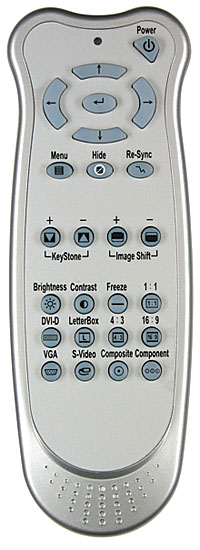 The second issue is light output. One of the reasons the black level is so good is that the projector isn't very bright, measuring only 8.785 foot-lamberts in our test. Given the low black level, the overall contrast ratio is still quite good, but the low light output makes it difficult to watch the H27 in a well-lit room. Optoma has wisely included a BriteMode that increases the projector's light output and, consequently, its black level. This mode adds several foot-lamberts to the brightness level without affecting the contrast ratio too much. (Again, see our measurements box for more details.) A few foot-lamberts won't make a difference in a really bright room, but it will improve the image in a moderately lit room. I should note that, through the DVI input, I was unable to turn off the BriteMode on my review sample, so I could not evaluate the picture at its darkest level (although the black level is still very good when BriteMode is on). However, Optoma says you should be able to turn the BriteMode on and off for each of the available inputs.
The second issue is light output. One of the reasons the black level is so good is that the projector isn't very bright, measuring only 8.785 foot-lamberts in our test. Given the low black level, the overall contrast ratio is still quite good, but the low light output makes it difficult to watch the H27 in a well-lit room. Optoma has wisely included a BriteMode that increases the projector's light output and, consequently, its black level. This mode adds several foot-lamberts to the brightness level without affecting the contrast ratio too much. (Again, see our measurements box for more details.) A few foot-lamberts won't make a difference in a really bright room, but it will improve the image in a moderately lit room. I should note that, through the DVI input, I was unable to turn off the BriteMode on my review sample, so I could not evaluate the picture at its darkest level (although the black level is still very good when BriteMode is on). However, Optoma says you should be able to turn the BriteMode on and off for each of the available inputs.
Feeling Perky
Ergonomic perks are another factor in the overall equation. The H27 scored huge bonus points with me by offering aspect-ratio adjustments for HD sources, something you don't often find even on pricey displays. Is this really that important, you may wonder? It is if your HD cable box stretches 4:3 material when you've got it set to output 1080i or 720p—as mine does. To view 4:3 sources in their correct shape, I normally have to go into the cable box's menu and manually set it for 480i output whenever I'm watching a 4:3 show. It's extraordinarily irritating, but it's the price I've chosen to pay in order to have an HD DVR box. With the H27, though, all I had to do was press the 4:3 aspect-ratio button on the remote to correctly format SD signals.
That's another perk, by the way—the excellent remote. It's got dedicated source and aspect-ratio buttons, plus brightness and contrast buttons that let you adjust these key parameters without having to access the menu. It's also backlit, a curious rarity in the display world. As someone at our test facility commented when I extolled this remote's virtues, "It sounds like this projector was designed by people who actually have to use it." Too true.
I did encounter one interesting ergonomic issue. When I set up the H27 in our normal projector location in our testing studio—on a rack about 14 feet away from our 87-inch-wide Da-Lite screen and about 28 inches off the floor—the throw angle was so high that the image was actually on the ceiling. We had to put the projector on the floor in order to center it on the screen. The image-shift and height-adjustment functions made little difference.
I didn't have the same problem when I set up the H27 as a tabletop projector in my home. My table is only about 7 feet from the screen, and I found the image height to be fine, but the projector needed more distance to fill my screen than my home projector.
Between the various projector locations, I was able to test the H27's performance at a variety of screen sizes, from 55 inches diagonally to 6 feet wide. While HDTV material looked more detailed at the smaller screen size, DVDs looked great regardless. In fact, through the DVI input in our studio's fully light-controlled theater, the 6-foot-wide DVD image was gorgeous.
So, we return again to the subject of value. Yes, you will need to mate the H27 with a projection screen. If you spend $1,000 on said screen, we're talking about $2,199 for a wonderful—and wonderfully large—picture. You won't find a better value in the flat-panel or microdisplay worlds. If you want a super-sized picture to provide a fine anchor for your blossoming home theater, you must check out Optoma's value menu.
Highlights
• Excellent black level
• A clean, smooth image
• A lot of picture for the price








